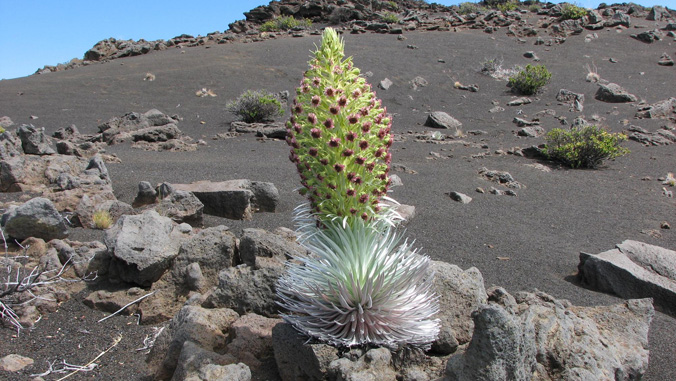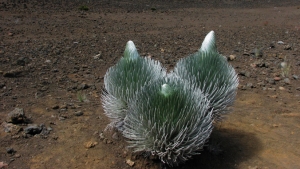
The Haleakalā silversword, already one of the rarest species in the Hawaiian Islands, has been declining in recent decades due to drier and warmer climate conditions. Efforts to restore the population should focus on outplanting new plants in geographic areas with the most favorable climatic conditions. That’s according to a three-year study by researchers from the University of Hawaiʻi at Mānoa’s College of Tropical Agriculture and Human Resources and the UH Botany department.
“The goal of our study was to understand the specific reasons why silverswords are dying in the wild,” said lead investigator Paul Krushelnycky, an entomologist in CTAHR’s Department of Plant and Environmental Protection Sciences. “The study helped us better understand what is likely driving the spatial pattern of mortality in the wild population. This is important for coming up with the most effective strategy to ensure the plant’s continued survival.”
The Haleakalā silversword lives only on the slopes of this volcano. Besides its rarity and dramatic appearance, it also plays a critical ecological role in its alpine desert environment, including acting as the habitat for several species of endemic insects. Beyond that, it’s a good indicator of what’s happening throughout the world as plants and animals are impacted by higher temperatures and changing rainfall patterns.

Predicting how plants will respond to increased future drought is difficult, because there are multiple factors influencing both drought resistance of plants and local climatic conditions. Krushelnycky and his co-authors, including Kasey Barton of UH Mānoa’s Botany department and Creighton Litton of CTAHR’s Department of Natural Resources and Environmental Management, conducted a detailed study of why the Haleakalā silversword has been dying off at lower elevations on the slope and how best to plant new plants that would survive.
After introducing new plants sourced from silverswords growing in different areas of the mountain and planting them at high, medium and low elevations, they tracked the plants for more than three years. They found that plants were more likely to survive at higher elevations, no matter where their seeds had come from. This matched the pattern of mortality in the wild population. They believe this is because lower-elevation plants grow up to be less drought-resistant than higher-elevation plants, and therefore die at higher rates during especially dry seasons.
Krushelnycky explained, “This means park managers should focus their efforts on identifying areas on the mountain where outplanting survival is likely to be highest, rather than trying to take advantage of more resistant genotypes.”
The study, “Clinal variation in drought resistance shapes past population declines and future management of a threatened plant,” appeared in Ecological Monographs of the Ecological Society of America.

